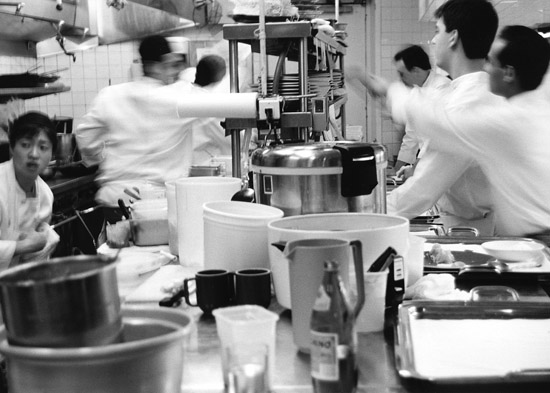The One Day Restaurant School
While so much of the allure of owning and operating a food-based business is focused on the cooking and baking, it’s the core business matters for which those in the trade often need the most ongoing support.

Improving a recipe often comes more naturally than maximizing profit margins. Learning from experienced peers is critical to keeping both dreams and business alive and thriving. In preparation for ICE’s new One Day Restaurant School program, an exclusive six-hour management seminar for restaurant owners and managers to learn skills to improve their business and grow their revenue, seasoned industry professionals Vin McCann and Julia Heyer sat with us to discuss the many challenges that restaurateurs face when attempting to successfully plan, launch and run a food business.
Vin McCann: Every opportunity I get to meet with a restaurant owner, I marvel at both the nerve and effort each of them has relied on to get into business. Whatever feeds these characteristics: whether a passion to excel, a sharp market insight, or the desire for the restaurant life, it is admirable.
But all too often I find that the praiseworthy determination has not been tempered with any solid, coherent business planning. In fact, it is often not tempered at all. Start-up costs explode budgets. Snappy designs are marred by dysfunctional production facilities. Ill-conceived restaurant concepts miss theirhoped-forr target guests. Many stores open without sufficient training.
Businesses generating healthy sales are unproductive when it comes to profits. The list of critical oversights is long and costly, and reminds me of that old oil filter commercial tag-line, “pay me now, or pay me later.” How many operations could be saved or enhanced if they spent the time and whatever money it took to plan the management strategies for each vital areas of their business.
Julia Heyer: Oh wow, Vin, you are getting me started on one of my favorite topics, and something I tend to spend a lot of time on with my clients: the planning – or often rather unfortunate lack thereof – during the design and pre-opening phase. Restaurant development is a complex puzzle.
Entrepreneurs generally realize this, but unfortunately,y they underestimate the pieces involved, mistaking the challenge for an 8,000 piece puzzle, when there really are 15,000 pieces they need to consider. In other words: It is not that people don’t ask questions… they often simply do not know which questions to ask and in which order.
A prime example: the 6 foot wide dish drop table for a 480 seat casual restaurant, planning on serving 425 guests per hour, using 8 different types of glasses and 12 styles of plate-ware… Can you see where I’m going here? Do some basic math and it turns out each of the guest uses an average of 2.5 glasses, 4.5 plates and 3 pieces of silverware. That makes 950 glasses, over 1,900 plates and 1,275 pieces of silverware hitting those 6 feet every hour. That’s 32 plates per minute hitting those six feet alone. You can’t squeeze enough dishwashers in the area to handle the volume and avoid serious breakage. Details matter, especially the functional ones.
Vin McCann: It’s no exaggeration, Jules. Details do matter, and restaurants, unlike so many other retail businesses, are all about function. We make, sell, and serve our products. Connecting the dots through those responsibilities under the banner of a coherent concept is trip down the rabbit hole of minutia.
Whether the size of the dish drop table or the size of the menu, the failure to address every connection point brings start-ups and loosely managed operations that much closer to failure. It is impossible to stress too much the need to understand the market, make the right location choice, avoid the pitfalls of a bad lease, or conduct comprehensive competitive research. Small margin businesses call for a critical eye for detail. Unless the marginal profits after food and labor are sufficient to cover the other costs, the thought of making profits up in volume is delusional.
Food and beverage portion control, along with recipe costing is vital to both consistency and profitability, but too many operators fail to engage in them. A good idea is simply not enough to launch a successful restaurant, and the effort and money invested must be tethered to a concept and operational planning buttressed by realistic sales and profitability projections. It ain’t rocket science, but it takes time, effort and teamwork to navigate the process.
Julia Heyer: I can’t tell you how many times I’ve heard, “Oh, we’ll figure that piece out once we are open.” It’s nearly as good as “we’ll fix that when we’re successful.” I’m not joking. Honestly, whether one is planning a new restaurant or trying to improve an existing one, the amount of work involved calls for a collaborative effort and the determination of who should do what. At the same time taking care to avoid the pitfall, “Zuviele Koeche verderben den Brei” which is the German equivalent of too many cooks spoil the broth.
Planning for optimal execution calls for recognizing who brings the appropriate and necessary skills and talents to the team, and also identifying which areas they probably shouldn’t be involved in. The objective is to get the best out of the team, by motivating them to march in ONE joint direction, which, of course, presumes a plan, and the ability to articulate it well… So many puzzle pieces, so little time!
Vin and Julia will be leading ICE’s One Day Restaurant School on Wednesday, October 17, from 9 a.m.-3 p.m., where they will focus on these and other topics that restaurant professionals face. Click here to register!


Add new comment